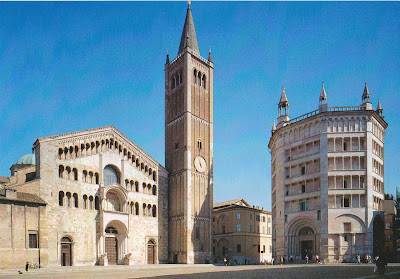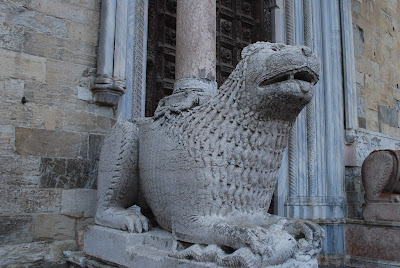Bologna is
known as "il rosso": the “red city”, partly because it is actually red in colour; built of
brick rather than marble, with even modern buildings often being plastered in
red stucco. The other reason is that it was traditionally run by the Communist
party: I found the party newspaper being sold on the streets even today.
Ever since the Renaissance this region of
Italy, the Emilia-Romagna, was part of the Papal States, ruled from Rome; it
rebelled unsuccessfully in 1848, and the Pope’s troops were only expelled when
Italy was unified in1861. The city was damaged by Allied bombing in the Second
World War, but was rebuilt in the traditional style, and the centre is still a
tangle of mediaeval buildings and confusing little streets.
These are views from the campanile tower of S. Petrino church on the Piazza Maggiore; the heart of
the old city. The redness of the old city is very clear, but note the
spectacular towers: some of half-a-dozen remaining from the Middle Ages.
Reaching the top of the tallest one, the Asinelli Tower, involves climbing
almost 500 steps, and I’m afraid I chickened out of making the attempt. Near
the towers are the old Jewish quarter and the student quarter.
Bologna boasts of having one of the most ancient universities in Europe, though some other Italian cities dispute this priority.
Bologna boasts of having one of the most ancient universities in Europe, though some other Italian cities dispute this priority.
Everyone
assumes S. Petrino is the cathedral of Bologna, but it isn’t. Its unfinished
state is very noticeable.
In the 14th
century, when the Popes lived in exile at Avignon in France, the city fathers
of Bologna planned to build for their city the biggest church in the world, but
when the Popes returned to Rome they were quick to put a stop to the project;
and what survives is only a fraction of what was planned. The church has a
mediaeval fresco of Heaven and Hell, which includes a scene of Mohammed being
devoured by Satan: this has led to a heavy presence of armed police in the
area, for fear of Islamic outrage. The piazza facing the church is surrounded
by fine mediaeval municipal buildings,
Wandering through the old city centre, we
came across more mediaeval buildings, like the Grassi Palace
and a great many churches, which were mostly in totally over-the-top Counter-reformation style. A noted exception to this is S. Stefano (actually a collection of chapels and cloisters)
which features a reproduction of the Holy Sepulchre,
Pilate’s courtyard (complete with a basin for washing his hands) and a Column of the Flagellation, in black marble. All this was built from the 5th century onwards, in a praiseworthy attempt to save the pious the trouble and expense of having to make a pilgrimage all the way to Jerusalem to see the real things! I also visited the town's mediaeval museum, but there was far too much to see in a single visit, and unfortunately no photographs were allowed.
and a great many churches, which were mostly in totally over-the-top Counter-reformation style. A noted exception to this is S. Stefano (actually a collection of chapels and cloisters)
which features a reproduction of the Holy Sepulchre,
Pilate’s courtyard (complete with a basin for washing his hands) and a Column of the Flagellation, in black marble. All this was built from the 5th century onwards, in a praiseworthy attempt to save the pious the trouble and expense of having to make a pilgrimage all the way to Jerusalem to see the real things! I also visited the town's mediaeval museum, but there was far too much to see in a single visit, and unfortunately no photographs were allowed.
Bologna is also known as the “fat city”,
since its cuisine is said to be the best in Italy. Our guide (a very nice young
lady called Antonia) impressed on us that we should never, under any
circumstances, ask for spaghetti bolognese in the city, this being essentially
an American invention. What the locals eat is actually tagliatelli with a ragu
sauce which, because it contains few if any tomatoes, is brown rather than red
in colour. Local delicacies include rabbit stuffed with figs (“coniglio”: which
is very tasty!) and a particular kind of veal cutlet with Parma ham and
parmesan cheese. Certainly Bologna seemed full of good-looking restaurants;
which made the sight of large queues at the local McDonald’s a particularly
depressing spectacle.
Our hotel, which I would recommend, was the
Internazionale on the Via Indipendenza: a wide boulevard driven from the
railway station straight to the heart of the old city. It was only a short walk to the Piazza
Maggiore, and impossible to get lost on the way. My window looked out on the
entrance to a large park, and in the early morning the sky was full of swifts.
But on Friday the streets opposite were taken over by a vast market, where many
of the stalls featured great piles of cheap clothes: rummage for what you can
find at 2 or 3 euros! Many of the stallholders were Asians. The streets in the
centre had numerous beggars: a variety of cripples and defeated-looking old men
and women, but also lots of young African men, who appeared to speak no Italian
and just stood around mutely holding out baseball caps for contributions. Who
were they? Refugees who had fled across the sea from Libya, perhaps?
On the
Thursday we were taken on a guided tour of Parma. Unlike Bologna, this was an
independent little Duchy ruled by the Farnese family. They owed their wealth
and prominence to the shameless nepotism of one Alexander Farnese, who in the
16th century became Pope Paul III and dedicated himself to the
wellbeing of his family. It was the Pope’s grandson, Alexander Farnese, Duke of
Parma, the greatest soldier of his age, who in 1588 was supposed to lead his
army across from Flanders on the Spanish Armada, but famously failed to do so.
In the 18th century the British government went to enormous trouble
to have Don Carlos, the son of Elizabeth Farnese the Queen of Spain, made Duke
of Parma without causing a diplomatic crisis. (Don Carlos later became King of
Spain himself, when with base ingratitude he took Spain into the Seven Years’
War against Britain – not that it did his country any good). When the map of
Europe was redrawn after the battle of Waterloo, Parma was given to Napoleon’s
widow, Marie Louise from the great Habsburg family, since no-one could think of
what else to do with her.
We entered Parma through the vast bulk of
the Farnese palace. Between the wars it was the headquarters of the local
Fascist Party, and was then badly damaged in wartime bombing, but has been
restored. In front of the palace was a large area of grass, which included a
random-looking collection of objects which were apparently an art installation.
There was also a statue of a young anti-fascist partisan fighter, who was
contemptuously turning his back on the palace.
The centre
of the old town was just a short walk away: a piazza fronted by the cathedral,
the baptistery and the episcopal palace.
This picture is taken from a postcard, because at our visit the area was full of thousands of small children celebrating the
start of their summer holidays, being organised and addressed by a DJ on a
disco system at maximum volume. Our guide abandoned her talk and we elbowed our
way through the dense crowds.
The cathedral dates from the 12th
century, with the campanile a century later. Outside it is guarded by two
impressive lions (described in the guidebook with the unusual word “columniferous”),
and inside the walls are covered with frescoes in the mannerist style. Two contrasting features are a 12th-century marble carving of the deposition from the cross
and a magnificent dome painted by Correggio in 1530.
The baptistery, dating from the 13th century, is even better, in pale pink marble, with splendid carvings above the portals
and inside, the walls and dome covered with mediaeval frescoes.
and inside the walls are covered with frescoes in the mannerist style. Two contrasting features are a 12th-century marble carving of the deposition from the cross
and a magnificent dome painted by Correggio in 1530.
The baptistery, dating from the 13th century, is even better, in pale pink marble, with splendid carvings above the portals
and inside, the walls and dome covered with mediaeval frescoes.
We could
have done with more time to explore Parma, but instead we were whisked away to
encounter local foodstuffs. First we were taken to what can only be called a
factory producing Parma ham. We were shown literally thousands of pigs’ hind
legs, hanging up to mature in near-freezing conditions (50,000 a year were
processed, we were told); the man in charge explaining to us how he pricked
them regularly with a large needle made from a horse’s tibia bone, and then
sniffed to make sure they were up to standard. Then it was on to Modena, where
the mysteries of making balsamic vinegar were explained to us. This bears no
relation at all to what we buy in the supermarkets, and since it takes 12 years
to mature (25 years for the best quality) it is incredibly expensive. Although
it did indeed taste very nice, I didn’t buy any. Incidentally, despite this being a rich farming region, we didn't see a single cow or pig. They are all kept indoors for the whole of their lives!


















No comments:
Post a Comment